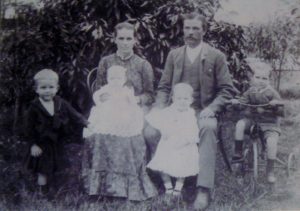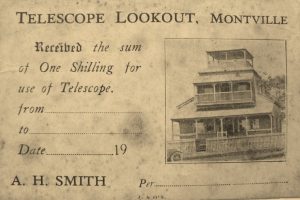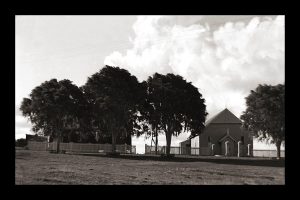Montville – A Brief History
The First People
The oral history of the original people of the Blackall Range relates that members of the Jinibara Federation, the Nalbo and Dallanbara clans rested at the lagoon in what is now called Russell Family Park on their way to the bunya nut festivals on the banks of the Obi Obi Creek at Baroon Pocket. They moved up from the coast on a track that is closely followed today by the Razorback Road and used the lagoon as a staging post for their final walk along Tarrawonga, the Western Avenue ridge, and down to Baroon Pocket. The bunya festival was a significant Aboriginal event. It was a time for feasting and celebration; for exchanging songs, stories, tools and ornaments; for marriages to be arranged; and for conflicts to be resolved.
Timber-getters exploited the rich timber resources of the Blackall Range before the separation of Queensland in 1859; however the new colony recognised the cultural significance of the bunya trees and protected the range from development until the late 1880s. At this time land around Montville was opened for selection, with early permits going to E. J. Burnett and G.L. Bury. Other early settlers included the Remington, Butt, Smith, Skein, Mills, Vining and Dalton families. These settlers cleared the land, using ‘shutes’ such as the Remington Shute off Balmoral Road to slide logs down the mountain to waiting bullock teams. Early crops included firstly gooseberries and corn, then bananas, strawberries and citrus, followed later by pineapples, macadamias, pecans and avocados.
Early Settlement

Jane and Henry Smith with children L to R Tom, Mabel, John and Alf, 1892
In 1893 Alfred Smith and his brother, Henry, selected land on the ‘back road’ or Western Road, now Western Avenue. Henry’s selection included what is now Montville Village, Russell Family Park and the gated community, ‘The Ranges’. Henry was a man of business. He built the first cattle dip, opened the first store and post office and ran the first private telephone line between his home, Eastnor, (now renamed Belbury) and his store at Palmwoods. At a community meeting he proposed the name, Montville after an earlier proposal of Razorback was rejected. Montville was named after a town in Connecticut, the state where some of the Smith family lived before emigrating to Australia. Henry’s son, Alf, built a shop on Main Street, a general business that sold hardware, manchester, haberdashery, basic chemist lines, gifts, toys and confectionery. Originally known as the ‘lolly shop’, when it was expanded upwards to incorporate an observatory and museum, it became known as the ‘wedding cake shop’. It came to be called Misty’s in the 1980s when it became a restaurant and the building is still known as that today.

Entry ticket to Telescope Lookout
Montville has always had a strong community spirit. In 1896, a provisional school was established on land donated by W. Berry. Miss Emily Palmer, later Mrs Emily Bulcock became the first teacher at the school. Today, the original building is incorporated in the old teacher’s residence on Razorback Lookout. In 1903, on land donated by Edward Smith, the Montville School of Arts hall was erected by the community with materials and labour donated by the community. The hall was managed by the School of Arts Committee, then the Montville Hall and Progress Association before becoming the responsibility of the Montville Village Association. Over the years the hall has been the hub of social activity for Montville hosting theatre groups, art groups, dances, and celebrations of special events.
Around this time, the Village Green was developed as a community space and hosted early cricket matches and picnics. In 1912 the Methodist Church (now Uniting Church) was built on Main Street, while St Mary’s Church of England was consecrated in 1914. In 1921, Memorial Close was created with an avenue of trees and the erection of Memorial Gates in front of the hall to commemorate not only those who served their country, but those who wanted to serve, but were ‘rejected’ on medical grounds.

The Montville Hall with Memorial Pillars and Commemorative Fig Trees on the Village Green
Today, the significance of this area is recognised by its listing as a heritage precinct and a smaller Village Green is now community space used for events and picnics. The development of the Russell Family Park behind Main Street is a welcome addition to community garden space, providing modern barbecues and picnic shelters around the lagoon while a small group supported by Barung, the Sunshine Coast Council and the Montville Village Association is recreating a forest of native plants endemic to the area.
Growth
Early access to Montville was up a rough track along the Razorback Ridge – the current Razorback Road. In 1929, the Palmwoods Road was completed. In that year, the Montville Sports and Recreation Ground was established by the Montville community and hosted cricket and tennis matches. At this time Montville was a thriving mountain holiday resort with many, legendary guesthouses. Fires have destroyed most of these famous, old, wooden buildings including Mayfield and Manjalda; however, the Lachlan building still stands on Main Street under the name, Rothley; and Belvedere is now a private residence on Balmoral Road. Mixed farming continued to be an important industry for Montville, and the Montville Fruit Growers Association won many awards for its exhibits in the Brisbane Exhibition. As well, an emerging arts and crafts industry became more prominent as roads improved and tourism increased. Today, however, the development of a range of accommodation venues, restaurants and cafes has meant that Montville has regained its reputation as a mountain holiday retreat.
The Declaration of the Blackall Range as an Iconic Place in 2008 has ensured the protection of both the natural and man-made environments of the Montville area. Around the same time, the development of the Sunshine Coast Hinterland Great walk has linked Montville’s two great environmental attractions, Lake Baroon and Kondalilla Falls. This walk follows Obi Obi Creek and offers spectacular views into the Obi Obi Gorge as it winds its way through lush temperate rain forests.
The permanent, pictorial postmark below, was issued in 1997 to commemorate one hundred years of postal service in Montville, and depicts the ‘wedding cake’ building (Misty’s) and a spray of Duchesse de Brabant Rose adopted as the Montville Rose.

 ©2016 Montville History Group. All rights reserved.
©2016 Montville History Group. All rights reserved.